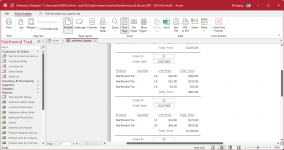Hello. I hope someone can help.
I have a main report and a subreport. I'm having some problems with the query.
1. two tables - employees_tbl and employees_records_tbl
2. 1 query - QRY_employees_by_employees_Begindaterange
3. 2 reports - RPT_Employees_Main and RPT_Employees_records_Bydatarange(subreport)
The report works find with the main report that displays the subreport without any queries.
My problem is when I change the query on the subreport, i get a listing of each employees multiple times with each records of the employees records.
The query that I am using on the subreport is on a field called Exclusion_Begin_Date :
Between [Enter the start date search of the Exclusion Begin Date field?] And [Enter the end date search for the Exclusion Begin Date field?]
I linked the main report and the subreport by ID from the main report to LinkedID on the subreport.
I like to see just one employee general info records and below the each record, have the list of employee records from the records table that are between the user input dates.
I hope I'm making sense here. Thank you for any help.
The way it looks now.
Nick Joma Cage
Type Initiated Begin Date End Date
1 Excluded Supervisor 01/01/23 01/02/23
Nick Joma Cage
Type Initiated Begin Date End Date
2 Excluded Manager 01/02/23 01/04/23
Nick Joma Cage
Type Initiated Begin Date End Date
1 Excluded Supervisor 01/06/23 01/09/23
Amy G Edwards
Type Initiated Begin Date End Date
3 Excluded Supervisor 01/04/23 01/08/23
Amy G Edwards
Type Initiated Begin Date End Date
1 Excluded Manager 01/02/23 01/05/23
I like it to look like this.
Nick Joma Cage
Type Initiated Begin Date End Date
1 Excluded Supervisor 01/01/23 01/02/23
2 Excluded Manager 01/02/23 01/04/23
1 Excluded Supervisor 01/06/23 01/09/23
Amy G Edwards
Type Initiated Begin Date End Date
3 Excluded Supervisor 01/04/23 01/08/23
1 Excluded Manager 01/02/23 01/05/23
I have a main report and a subreport. I'm having some problems with the query.
1. two tables - employees_tbl and employees_records_tbl
2. 1 query - QRY_employees_by_employees_Begindaterange
3. 2 reports - RPT_Employees_Main and RPT_Employees_records_Bydatarange(subreport)
The report works find with the main report that displays the subreport without any queries.
My problem is when I change the query on the subreport, i get a listing of each employees multiple times with each records of the employees records.
The query that I am using on the subreport is on a field called Exclusion_Begin_Date :
Between [Enter the start date search of the Exclusion Begin Date field?] And [Enter the end date search for the Exclusion Begin Date field?]
I linked the main report and the subreport by ID from the main report to LinkedID on the subreport.
I like to see just one employee general info records and below the each record, have the list of employee records from the records table that are between the user input dates.
I hope I'm making sense here. Thank you for any help.
The way it looks now.
Nick Joma Cage
Type Initiated Begin Date End Date
1 Excluded Supervisor 01/01/23 01/02/23
Nick Joma Cage
Type Initiated Begin Date End Date
2 Excluded Manager 01/02/23 01/04/23
Nick Joma Cage
Type Initiated Begin Date End Date
1 Excluded Supervisor 01/06/23 01/09/23
Amy G Edwards
Type Initiated Begin Date End Date
3 Excluded Supervisor 01/04/23 01/08/23
Amy G Edwards
Type Initiated Begin Date End Date
1 Excluded Manager 01/02/23 01/05/23
I like it to look like this.
Nick Joma Cage
Type Initiated Begin Date End Date
1 Excluded Supervisor 01/01/23 01/02/23
2 Excluded Manager 01/02/23 01/04/23
1 Excluded Supervisor 01/06/23 01/09/23
Amy G Edwards
Type Initiated Begin Date End Date
3 Excluded Supervisor 01/04/23 01/08/23
1 Excluded Manager 01/02/23 01/05/23
Last edited:

